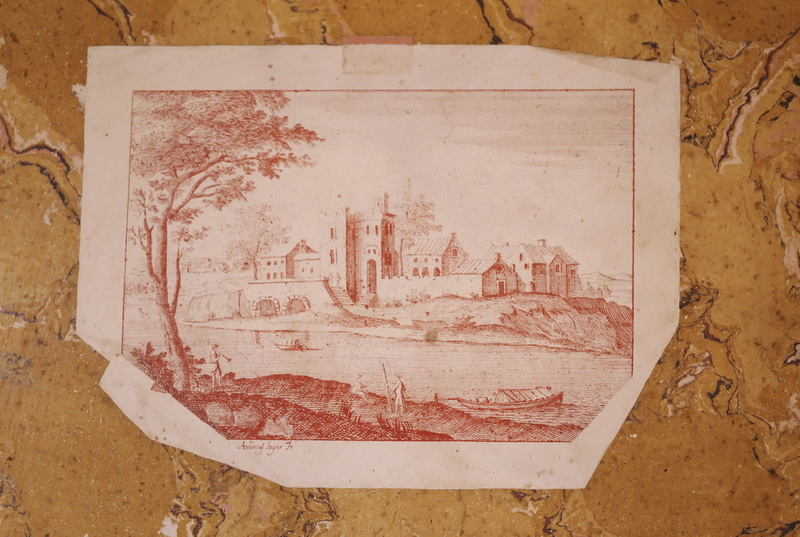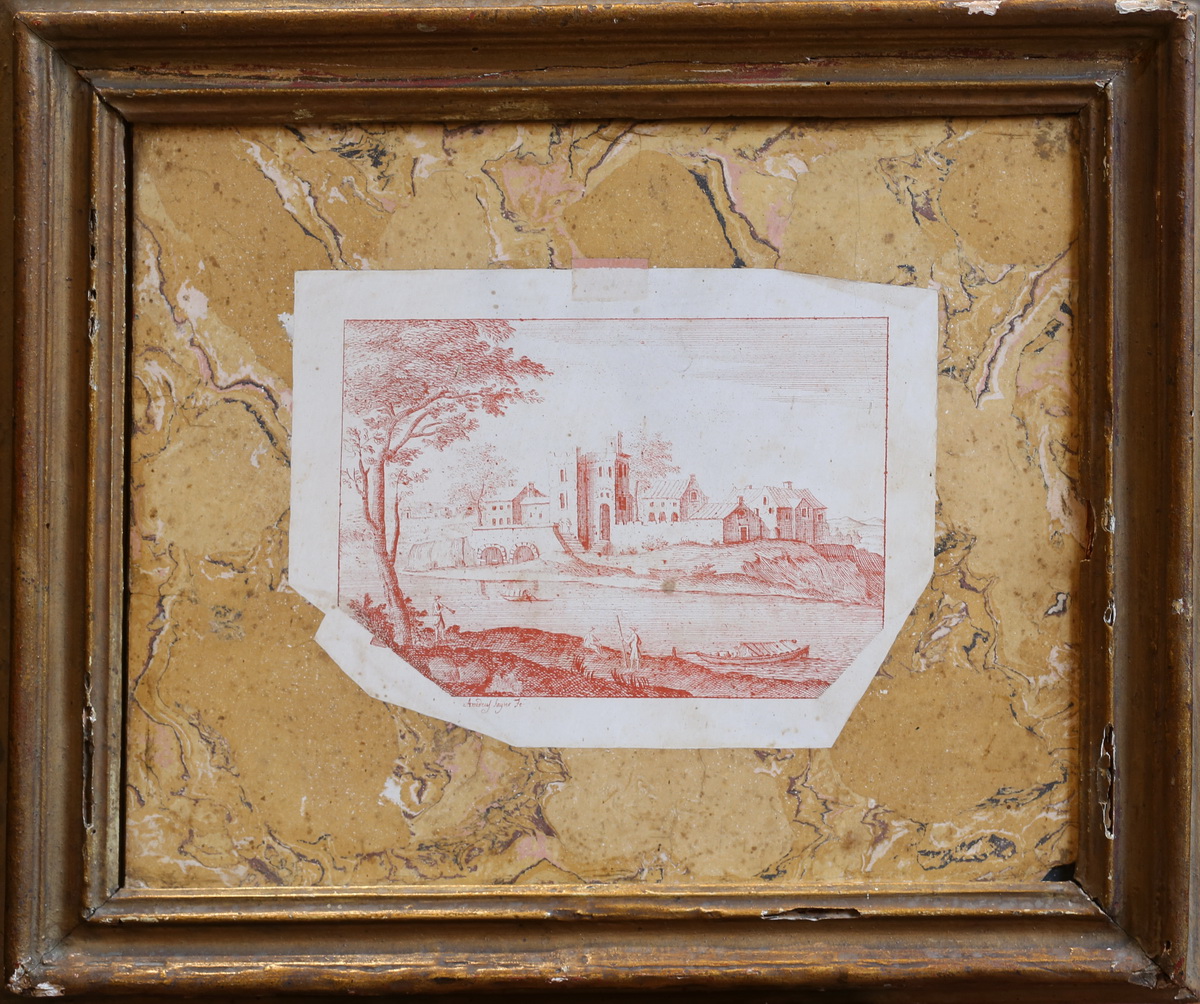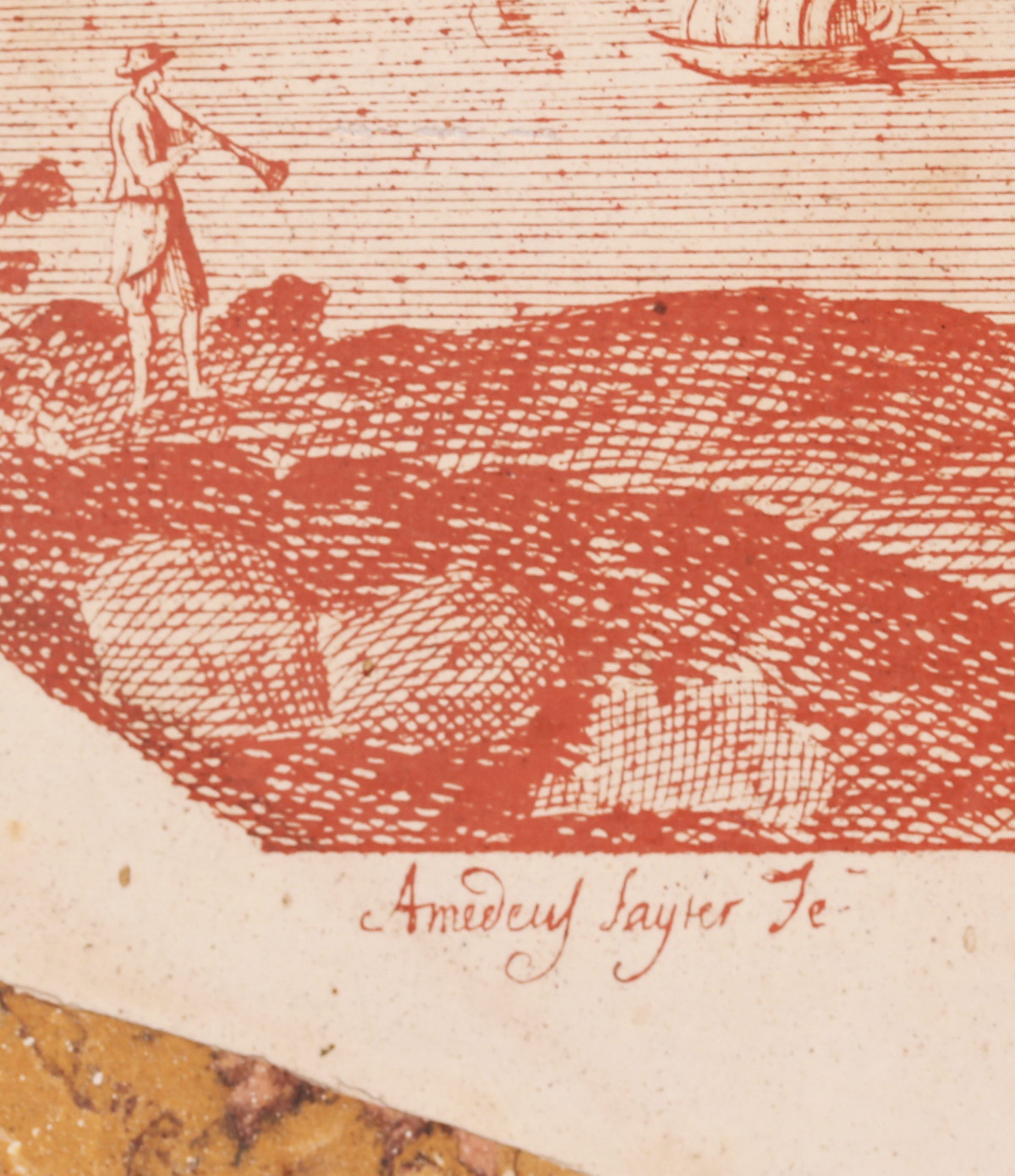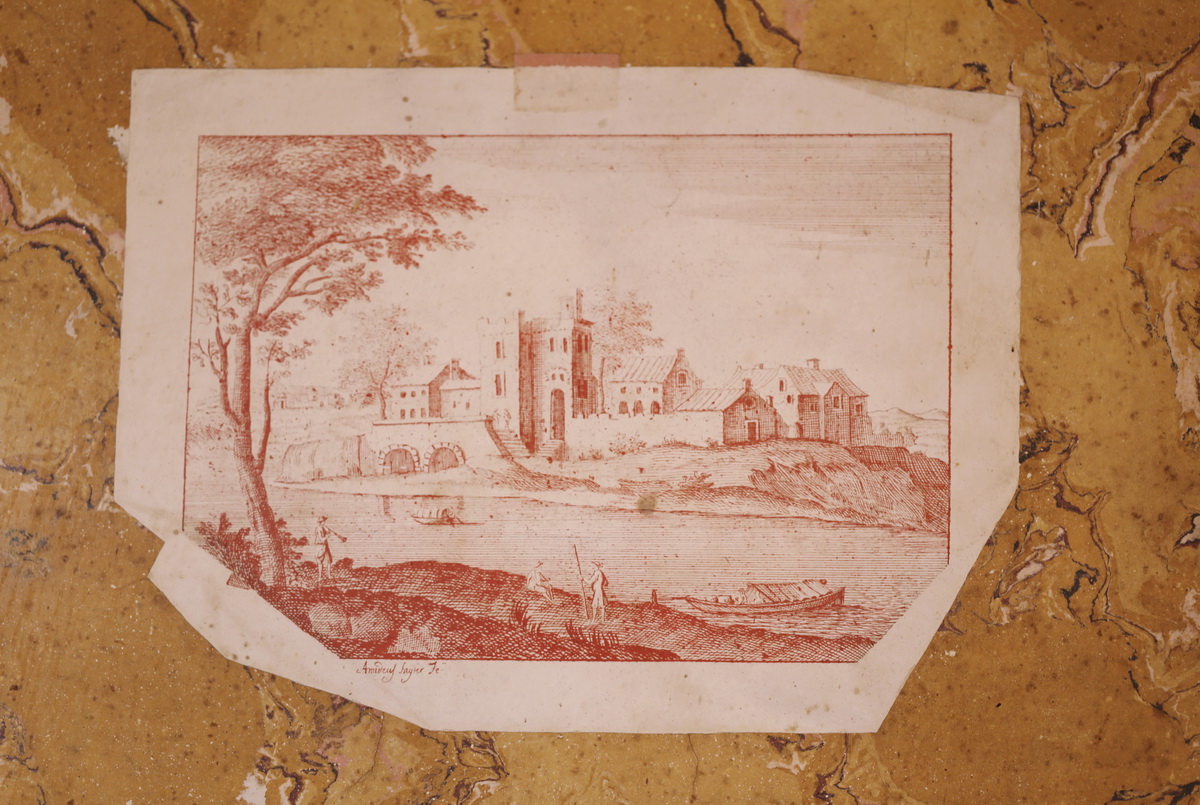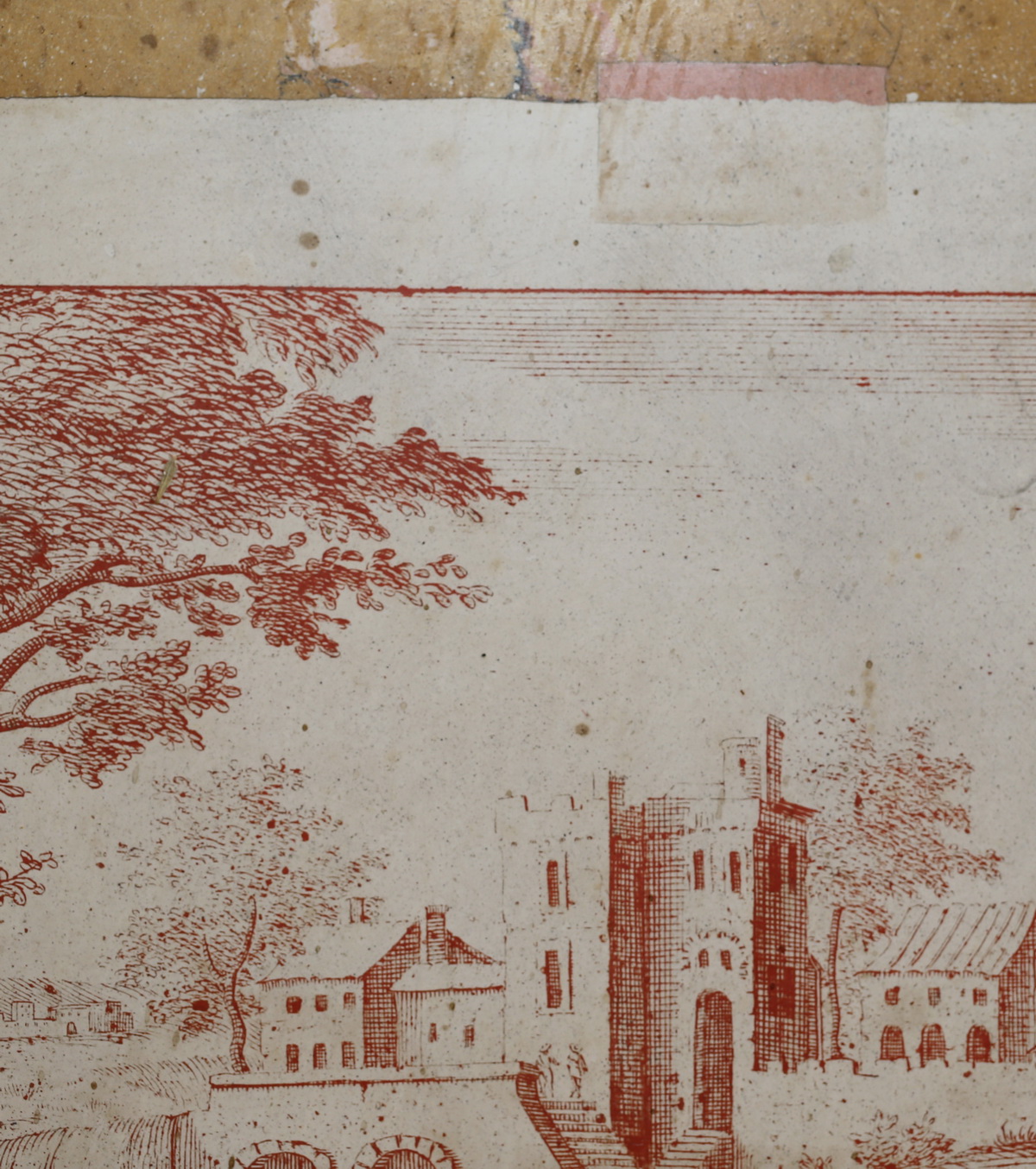> Home > Century XVI-XVII-XVIII th painting > Amedeus SAYTER Fecit circa 1720
Amedeus SAYTER Fecit circa 1720
Reference : A1232-0037
Price : 18 000 €
SEYTER Amadeus Rome 1720 drawing blood "animated landscape" trompe l'oeil on a marble top, scagliole, signed lower left. The Scagliola paintings were highly prized by aristocratic travelers who have acquired during their Grand Tour in the 18th and early 19th century.
The Seyter family had German origins and the first artist in the family was Seyter Daniele, born in Vienna in 1649 who died in Turin in 1705. He had three parents working in the middle of scagliola: Pietro Amedeo Tarsilla and Vittoria who Seyter were active in Rome in the 18th century.
Their work is characterized by scagliola simulation prints. As with scagliola panels that were made in Carpi, the brothers Seyter used only two colors, usually red with cross hatching on a white background. Their work has also simulated marble paper and through effective use of sham. Amedeo was active between 1712 and 1734 in Turin and Rome, he preferred views of landscapes with rivers and also "Capricci" with Roman ruins.
The scagliola technique has been used since Roman times to imitate marble is composed of pulverized selenite Apennine in Emilia and Tuscany called lazuli or specularis Pierre di luna which is then ground and mixed with lime. This mixture is then placed on a stone support and inlaid with a composition of scagliola colored and graphite.
SEYTER Amadeus Rome 1720 drawing blood "animated landscape" trompe l'oeil on a marble top, scagliole, signed lower left. The Scagliola paintings were highly prized by aristocratic travelers who have acquired during their Grand Tour in the 18th and early 19th century.
The Seyter family had German origins and the first artist in the family was Seyter Daniele, born in Vienna in 1649 who died in Turin in 1705. He had three parents working in the middle of scagliola: Pietro Amedeo Tarsilla and Vittoria who Seyter were active in Rome in the 18th century.
Their work is characterized by scagliola simulation prints. As with scagliola panels that were made in Carpi, the brothers Seyter used only two colors, usually red with cross hatching on a white background. Their work has also simulated marble paper and through effective use of sham. Amedeo was active between 1712 and 1734 in Turin and Rome, he preferred views of landscapes with rivers and also "Capricci" with Roman ruins.
The scagliola technique has been used since Roman times to imitate marble is composed of pulverized selenite Apennine in Emilia and Tuscany called lazuli or specularis Pierre di luna which is then ground and mixed with lime. This mixture is then placed on a stone support and inlaid with a composition of scagliola colored and graphite.
Price : 18 000 €
SEYTER Amadeus Rome 1720 drawing blood "animated landscape" trompe l'oeil on a marble top, scagliole, signed lower left. The Scagliola paintings were highly prized by aristocratic travelers who have acquired during their Grand Tour in the 18th and early 19th century.
The Seyter family had German origins and the first artist in the family was Seyter Daniele, born in Vienna in 1649 who died in Turin in 1705. He had three parents working in the middle of scagliola: Pietro Amedeo Tarsilla and Vittoria who Seyter were active in Rome in the 18th century.
Their work is characterized by scagliola simulation prints. As with scagliola panels that were made in Carpi, the brothers Seyter used only two colors, usually red with cross hatching on a white background. Their work has also simulated marble paper and through effective use of sham. Amedeo was active between 1712 and 1734 in Turin and Rome, he preferred views of landscapes with rivers and also "Capricci" with Roman ruins.
The scagliola technique has been used since Roman times to imitate marble is composed of pulverized selenite Apennine in Emilia and Tuscany called lazuli or specularis Pierre di luna which is then ground and mixed with lime. This mixture is then placed on a stone support and inlaid with a composition of scagliola colored and graphite.
SEYTER Amadeus Rome 1720 drawing blood "animated landscape" trompe l'oeil on a marble top, scagliole, signed lower left. The Scagliola paintings were highly prized by aristocratic travelers who have acquired during their Grand Tour in the 18th and early 19th century.
The Seyter family had German origins and the first artist in the family was Seyter Daniele, born in Vienna in 1649 who died in Turin in 1705. He had three parents working in the middle of scagliola: Pietro Amedeo Tarsilla and Vittoria who Seyter were active in Rome in the 18th century.
Their work is characterized by scagliola simulation prints. As with scagliola panels that were made in Carpi, the brothers Seyter used only two colors, usually red with cross hatching on a white background. Their work has also simulated marble paper and through effective use of sham. Amedeo was active between 1712 and 1734 in Turin and Rome, he preferred views of landscapes with rivers and also "Capricci" with Roman ruins.
The scagliola technique has been used since Roman times to imitate marble is composed of pulverized selenite Apennine in Emilia and Tuscany called lazuli or specularis Pierre di luna which is then ground and mixed with lime. This mixture is then placed on a stone support and inlaid with a composition of scagliola colored and graphite.
Dimensions :
Width : 15 inch, Height : 12 inch, height frame : 15 inch, Largeur cadre : 18 inch
Width : 15 inch, Height : 12 inch, height frame : 15 inch, Largeur cadre : 18 inch







